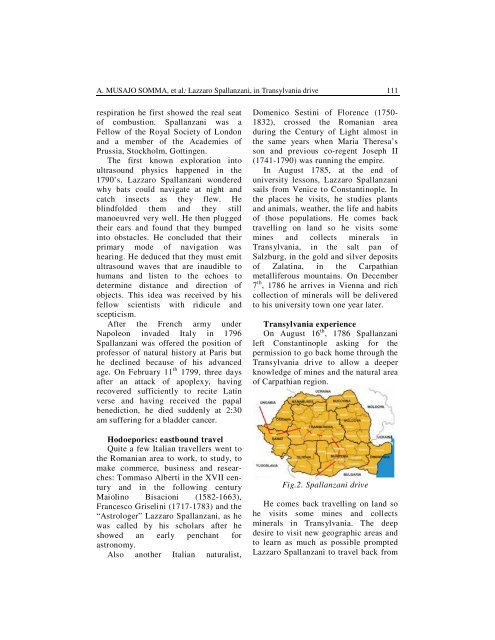Series VI: Medical Sciences – SUPPLEMENT ... - Krongres
Series VI: Medical Sciences – SUPPLEMENT ... - Krongres
Series VI: Medical Sciences – SUPPLEMENT ... - Krongres
You also want an ePaper? Increase the reach of your titles
YUMPU automatically turns print PDFs into web optimized ePapers that Google loves.
A. MUSAJO SOMMA, et al: Lazzaro Spallanzani, in Transylvania drive 111<br />
respiration he first showed the real seat<br />
of combustion. Spallanzani was a<br />
Fellow of the Royal Society of London<br />
and a member of the Academies of<br />
Prussia, Stockholm, Gottingen.<br />
The first known exploration into<br />
ultrasound physics happened in the<br />
1790’s. Lazzaro Spallanzani wondered<br />
why bats could navigate at night and<br />
catch insects as they flew. He<br />
blindfolded them and they still<br />
manoeuvred very well. He then plugged<br />
their ears and found that they bumped<br />
into obstacles. He concluded that their<br />
primary mode of navigation was<br />
hearing. He deduced that they must emit<br />
ultrasound waves that are inaudible to<br />
humans and listen to the echoes to<br />
determine distance and direction of<br />
objects. This idea was received by his<br />
fellow scientists with ridicule and<br />
scepticism.<br />
After the French army under<br />
Napoleon invaded Italy in 1796<br />
Spallanzani was offered the position of<br />
professor of natural history at Paris but<br />
he declined because of his advanced<br />
age. On February 11 th 1799, three days<br />
after an attack of apoplexy, having<br />
recovered sufficiently to recite Latin<br />
verse and having received the papal<br />
benediction, he died suddenly at 2:30<br />
am suffering for a bladder cancer.<br />
Hodoeporics: eastbound travel<br />
Quite a few Italian travellers went to<br />
the Romanian area to work, to study, to<br />
make commerce, business and researches:<br />
Tommaso Alberti in the X<strong>VI</strong>I century<br />
and in the following century<br />
Maiolino Bisacioni (1582-1663),<br />
Francesco Griselini (1717-1783) and the<br />
“Astrologer” Lazzaro Spallanzani, as he<br />
was called by his scholars after he<br />
showed an early penchant for<br />
astronomy.<br />
Also another Italian naturalist,<br />
Domenico Sestini of Florence (1750-<br />
1832), crossed the Romanian area<br />
during the Century of Light almost in<br />
the same years when Maria Theresa’s<br />
son and previous co-regent Joseph II<br />
(1741-1790) was running the empire.<br />
In August 1785, at the end of<br />
university lessons, Lazzaro Spallanzani<br />
sails from Venice to Constantinople. In<br />
the places he visits, he studies plants<br />
and animals, weather, the life and habits<br />
of those populations. He comes back<br />
travelling on land so he visits some<br />
mines and collects minerals in<br />
Transylvania, in the salt pan of<br />
Salzburg, in the gold and silver deposits<br />
of Zalatina, in the Carpathian<br />
metalliferous mountains. On December<br />
7 th , 1786 he arrives in Vienna and rich<br />
collection of minerals will be delivered<br />
to his university town one year later.<br />
Transylvania experience<br />
On August 16 th , 1786 Spallanzani<br />
left Constantinople asking for the<br />
permission to go back home through the<br />
Transylvania drive to allow a deeper<br />
knowledge of mines and the natural area<br />
of Carpathian region.<br />
Fig.2. Spallanzani drive<br />
He comes back travelling on land so<br />
he visits some mines and collects<br />
minerals in Transylvania. The deep<br />
desire to visit new geographic areas and<br />
to learn as much as possible prompted<br />
Lazzaro Spallanzani to travel back from


